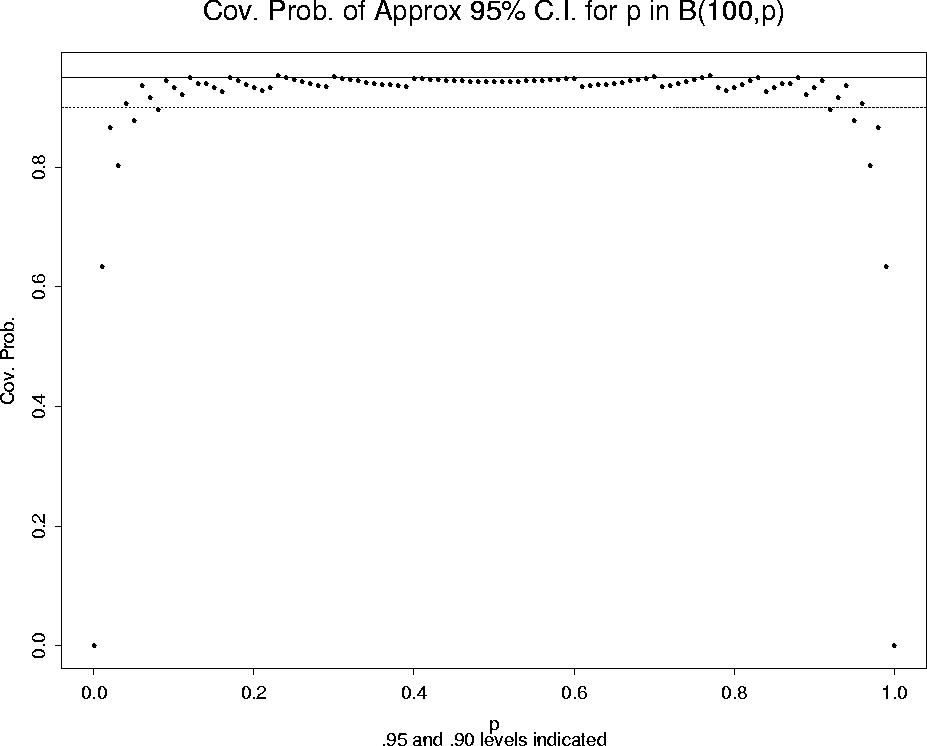Here, we compute the actual coverage probability of the ``usual''
confidence interval for the success probability p in a Binomial
Experiment. This interval is based on the normal approximation.
Suppose ![]() where
where ![]() is unknown. If
n is large (and p is not too close to 0 or 1), then the
point estimate
is unknown. If
n is large (and p is not too close to 0 or 1), then the
point estimate ![]() = Y/n has approximately a
normal distribution. More precisely,
= Y/n has approximately a
normal distribution. More precisely,
![]() is approximately N(0,1),
or we say
is approximately N(0,1),
or we say
Thus,
![]()
One can also show that
This will follow from Slutsky's theorem, and will be shown later in the course. Now with a little algebra on the inequalities defining the event we have
Thus,
gives an approximate  confidence interval for p
if n is large (and p is not too close to 0 or 1).
confidence interval for p
if n is large (and p is not too close to 0 or 1).
So the nominal coverage probability is  , but what is
the actual coverage probability? To investigate this, we
wrote an Splus function to determine first what the confidence
interval is for given values of n, y (the realization of Y),
and the nominal coverage probability:
, but what is
the actual coverage probability? To investigate this, we
wrote an Splus function to determine first what the confidence
interval is for given values of n, y (the realization of Y),
and the nominal coverage probability:
> Na0int
function(n, y, nominal)
{
# computes approx. confidence interval for binomial p
# based on simple normal approx. with given "nominal" cov. prob.
#
alpha <- 1 - nominal
zalpha <- qnorm(1 - alpha/2)
phat <- y/n
se <- sqrt((phat * (1 - phat))/n)
halfwidth <- zalpha * se
pmin <- phat - halfwidth
pmax <- phat + halfwidth
return(pmin, pmax)
}
Then we wrote an Splus function to compute the actual coverage
probability for given p:
> Na0covprob
function(n, p, nominal)
{
# computes true cov prob of approx. confidence interval for binomial p
# based on simple normal approx. with given "nominal" cov. prob.
#
covprob.o <- 0
covprob.c <- 0
for(y in 0:n) {
interval <- Na0int(n, y, nominal)
if(interval[[1]] < p & p < interval[[2]])
covprob.o <- covprob.o + dbinom(y, n, p)
if(interval[[1]] <= p & p <= interval[[2]])
covprob.c <- covprob.c + dbinom(y, n, p)
}
return(covprob.o, covprob.c)
}
We looped over the last one with n = 100, nominal coverage of  ,
and for p = 0, 0.01, 0.02,
,
and for p = 0, 0.01, 0.02,
![]()
Figure:
Plot of coverage probability for nominal 95%
confidence interval of p from B(100,p) observation
based on normal approximation to binomial.

Figure:
Plot of coverage probability for nominal 95%
confidence interval of p from B(100,p) observation
based on normal approximation to binomial for a smaller
range of values of p.